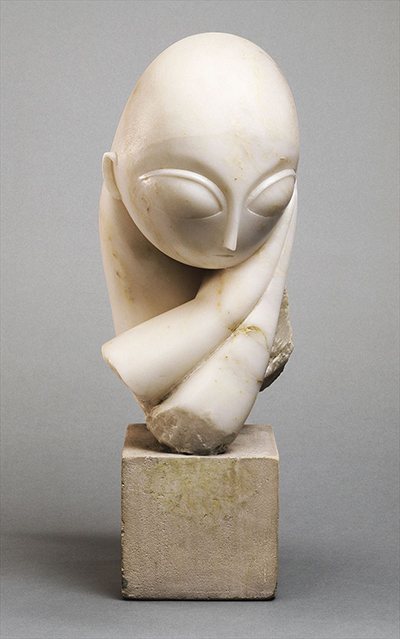The Romanian-born sculptor Constantin Brâncuși, who spent the bulk of his creative life in France, has gone down in the history of art as one of the most influential figures in twentieth-century sculpture. He helped to move the medium away from the strictly representational mode and into more abstract territory.
Nobody who has seen the extreme stylistation and minimalism of his 1907 sculpture The Kiss could forget its striking effect on the viewer - and that is just one of his better-known works. Throughout his career, which lasted until his death in 1957, Constantin Brâncuși created an entire array of boldly experimental sculptures. Mademoiselle Pogany is another of Brâncuși's better-known pieces. Sculpted in marvel with a limestone block, the work is - ostensibly - a portrait. But it is a portrait that abandons entirely any pretence to being representational.
The subject's head is rendered as a smooth ovoid with exaggerated, heavily stylised features: the eyes are large and almond-shaped ,the nose a smooth bridge between them. the mouth and ears reduced to mere vestiges, the hair left off entirely. The head rests on two hands, which are likewise so stylised that they serve merely as the impression of hands; truncated at the wrists, they resemble two tusks of ivory. A featureless block descends from the head, to suggest the rough outline of a neck.
And yet, for all of its minimalism, Mademoiselle Pogany remains full of life. The second we glance at it, the sculpture's abstract impressions combine to form the vivid image of a woman resting her head on her hands. While her expression is unreadable, this is not the same as blankness: it merely invites the audience to project their own emotions onto the sculpture. Looking at the image, we start to wonder who the real Mademoiselle Pogany was, and what character traits Constantin Brâncuși was attempting to capture in his sculpture of her. The result is alluring, enigmatic, and captivating. Small wonder that even within the context of Constantin Brâncuși's inventive and ground-breaking career as a sculptor, Mademoiselle Pogany remains one of his best-known works.
So striking is the sculpture that its appeal remains even in two-dimensional reproductions. If you place a print of Mademoiselle Pogany by Constantin Brancusi on display in your household, you can count on it bringing a touch of mystery to your home. Visitors will comment on it, while members of the family will draw inspiration from it day after day. There is a good reason why this sculpture has stood the test of time for more than a hundred years: if you purchase a print of Mademoiselle Pogany, you will be able to capture some of its eternal mystery and invention for yourself.




